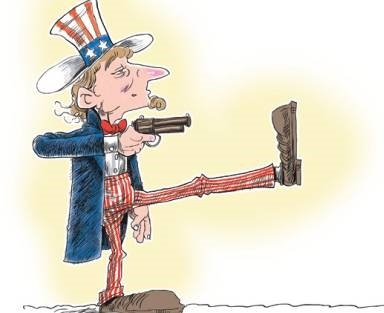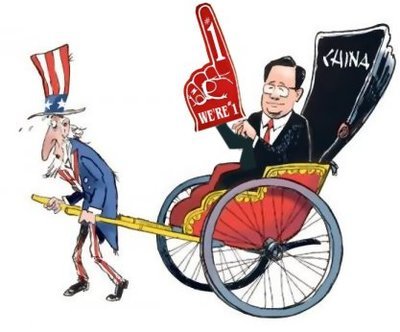US Government Promotes EV's; Result Is Gifting Chinese Electric Vehicle Auto Makers Billions Of Dollars and Increased Support For Attempt At EV World Domination
 |
 |
• SEE ALSO: Electric Vehicles, Solution or Diversion?
• SEE ALSO: Big Oil (STILL) Benefits From Alt Fuel "Divide and Conquer"
• SEE ALSO: Electric vehicles, a new key source of power demand for electric utilities
• SEE ALSO: SUV's, Pickups and Big Cars with Choice of Fuel, Is What's Good for America
Anton Wahlman in his blog on Seeking Alpha:
•A few Senators introduced a new EV subsidy bill: 400,000 cars at $7,000 each, per manufacturer.
•You just wait to see a long list of Chinese automakers now starting to sell in the U.S. to take advantage of this U.S. taxpayer gift.
•Meanwhile, U.S. demand for Teslas near-term will likely plummet, as consumes hold out for the prospect of a greater taxpayer gift in 2020 or 2021.
•While waiting, they may buy a different EV instead, from any of the other automakers where a $7,500 subsidy is available right away.
•Trump has said he is totally opposed to this kind of thing, but if he changes his mind, it would be good for Tesla as early as 2020 -- but 2019 would still be a disaster.
You’re all seen it by now, a handful of Senators are introducing a bill to add another 400,000 cars eligible for a $7,000 Federal subsidy: Stabenow, Alexander, Peters, Collins, Kildee Introduce Bipartisan Bill to Expand Electric Vehicle and Hydrogen Fuel Cell Tax Credits | U.S. Senator Debbie Stabenow of Michigan That’s $2.8 billion per automaker.
Before you even ask the question, let’s propose this new business idea: Each automaker should start several new automakers, perhaps with some seed money, and each new entity could then collect the $2.8 billion each. Yes, I know, it’s the consumer that gets the money directly, but indirectly that’s still a $7,000 per car benefit to the automaker.
So, let’s say we have 30 (and growing) eligible automakers, including a swarm of Chinese companies, as they are all electric and would set up shop in the U.S. in a nanosecond if this bill passed. Then do the math: $2.8 billion per automaker… soon enough you’re at $100 billion.
The major beneficiaries here would be the Chinese automakers, as they would enter the U.S. market to take advantage of any gift that Congress and Trump would give them. $2.8 billion per company, at the U.S. taxpayer’s expense!
That’s the one insane side of the equation. But it gets worse, especially for Tesla (TSLA), surprisingly.
Now that the prospect of the subsidy once again going up to $7,000, perhaps in 2020 or 2021, is in the air as a political football, what does that do to the marginal U.S. Tesla buyer? One word: Wait, if you can.
Basically, why buy a Tesla now at a smaller subsidy, when you may get a bigger one in 2020 or 2021? Unless you really need that new toy right now, or otherwise want it so badly, the marginal buyer may be wise to wait at least until 2020, and probably 2021.
I am not saying Tesla’s U.S. sales will go to zero this June, or even in the second half of 2019. Some people will still buy. However, on the margin, the talk of potential subsidy hikes in future years will make some prospective buyers wait -- and perhaps consider another electric car instead.
For example, the Chevrolet (GM) Bolt EV, Hyundai Kona EV, Kia Niro EV, Kia Soul EV, Nissan LEAF, Jaguar i-Pace or Audi eTron, just to mention some of those that are or will be on sale right here in 2019. Of course, in 2020, many more from Mercedes, Volvo/Polestar, Volkswagen, Porsche and many more.
There is no question that if this bill -- or some close variant of it -- were to become law, it would be good for Tesla, once it takes into effect. However, the next 18 months or so may be a long waiting game to see if Trump will sign any such bill, assuming it passes both houses of the U.S. Congress. So far, every indication is that Trump won’t sign any such bill. Of course, as with almost all things Trump, that could change.
But the waiting game is very bad for Tesla. It doesn’t add a single sale in the near term. Rather, it subtracts an unknown number who are willing to wait and hold out for the potential of a greater subsidy in a year or two. And in the meantime, they may just go pick up another electric car instead, as most of them still have some $7,500 subsidy units left.
Let’s start by seeing how this impacts Tesla’s Q2 sales. How many thousands of units will be lost, as a result of hoping for a greater subsidy in 2020 or 2021? What is your estimate for Tesla’s Q2 unit sales -- both globally and the U.S. number?


